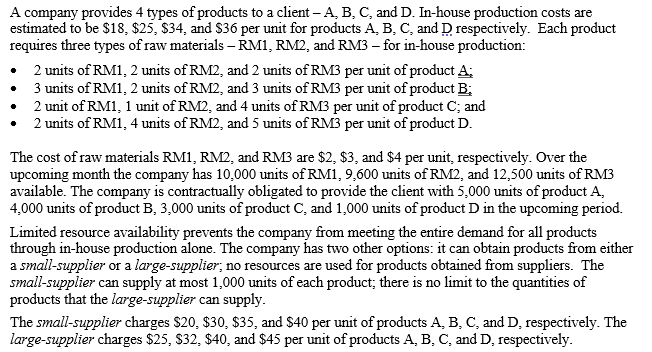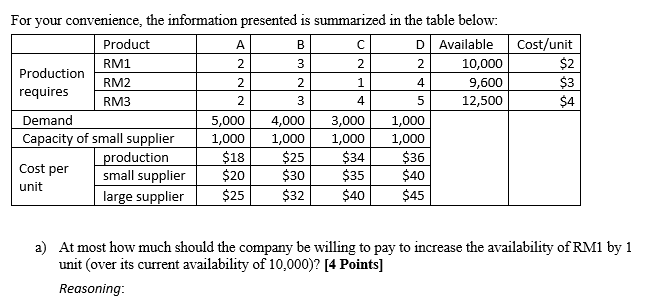

A company provides 4 types of products to a client - A, B, C, and D. In-house production costs are estimated to be $18. $25, $34, and $36 per unit for products A, B, C, and D respectively. Each product requires three types of raw materials - RM1, RM2, and RM3 - for in-house production: 2 units of RM1, 2 units of RM2, and 2 units of RM3 per unit of product A; 3 units of RMI, 2 units of RM2, and 3 units of RM3 per unit of product B; 2 unit of RMI, 1 unit of RM2, and 4 units of RM3 per unit of product C; and 2 units of RM1, 4 units of RM2, and 5 units of RM3 per unit of product D. The cost of raw materials RMI, RM2, and RM3 are $2, $3, and $4 per unit, respectively. Over the upcoming month the company has 10,000 units of RM1, 9,600 units of RM2, and 12,500 units of RM3 available. The company is contractually obligated to provide the client with 5,000 units of product A, 4,000 units of product B, 3,000 units of product C, and 1,000 units of product D in the upcoming period. Limited resource availability prevents the company from meeting the entire demand for all products through in-house production alone. The company has two other options: it can obtain products from either a small-supplier or a large-supplier, no resources are used for products obtained from suppliers. The small-supplier can supply at most 1,000 units of each product; there is no limit to the quantities of products that the large-supplier can supply. The small-supplier charges $20, $30, $35, and $40 per unit of products A, B, C, and D, respectively. The large-supplier charges $25, $32, $40, and $45 per unit of products A, B, C, and D, respectively. 2 Cost/unit $2 $3 $4 2 1 4 For your convenience, the information presented is summarized in the table below: Product A B D Available RM1 2 3 2 10,000 Production RM2 2 9,600 requires RM3 2 3 4 5 12,500 Demand 5,000 4,000 3,000 1,000 Capacity of small supplier 1,000 1,000 1,000 1,000 production $18 $25 $34 $36 Cost per small supplier $20 $30 $35 $40 unit large supplier $25 $32 $40 $45 WIN a) At most how much should the company be willing to pay to increase the availability of RM1 by 1 unit (over its current availability of 10,000)? [4 Points] Reasoning: A company provides 4 types of products to a client - A, B, C, and D. In-house production costs are estimated to be $18. $25, $34, and $36 per unit for products A, B, C, and D respectively. Each product requires three types of raw materials - RM1, RM2, and RM3 - for in-house production: 2 units of RM1, 2 units of RM2, and 2 units of RM3 per unit of product A; 3 units of RMI, 2 units of RM2, and 3 units of RM3 per unit of product B; 2 unit of RMI, 1 unit of RM2, and 4 units of RM3 per unit of product C; and 2 units of RM1, 4 units of RM2, and 5 units of RM3 per unit of product D. The cost of raw materials RMI, RM2, and RM3 are $2, $3, and $4 per unit, respectively. Over the upcoming month the company has 10,000 units of RM1, 9,600 units of RM2, and 12,500 units of RM3 available. The company is contractually obligated to provide the client with 5,000 units of product A, 4,000 units of product B, 3,000 units of product C, and 1,000 units of product D in the upcoming period. Limited resource availability prevents the company from meeting the entire demand for all products through in-house production alone. The company has two other options: it can obtain products from either a small-supplier or a large-supplier, no resources are used for products obtained from suppliers. The small-supplier can supply at most 1,000 units of each product; there is no limit to the quantities of products that the large-supplier can supply. The small-supplier charges $20, $30, $35, and $40 per unit of products A, B, C, and D, respectively. The large-supplier charges $25, $32, $40, and $45 per unit of products A, B, C, and D, respectively. 2 Cost/unit $2 $3 $4 2 1 4 For your convenience, the information presented is summarized in the table below: Product A B D Available RM1 2 3 2 10,000 Production RM2 2 9,600 requires RM3 2 3 4 5 12,500 Demand 5,000 4,000 3,000 1,000 Capacity of small supplier 1,000 1,000 1,000 1,000 production $18 $25 $34 $36 Cost per small supplier $20 $30 $35 $40 unit large supplier $25 $32 $40 $45 WIN a) At most how much should the company be willing to pay to increase the availability of RM1 by 1 unit (over its current availability of 10,000)? [4 Points] Reasoning








